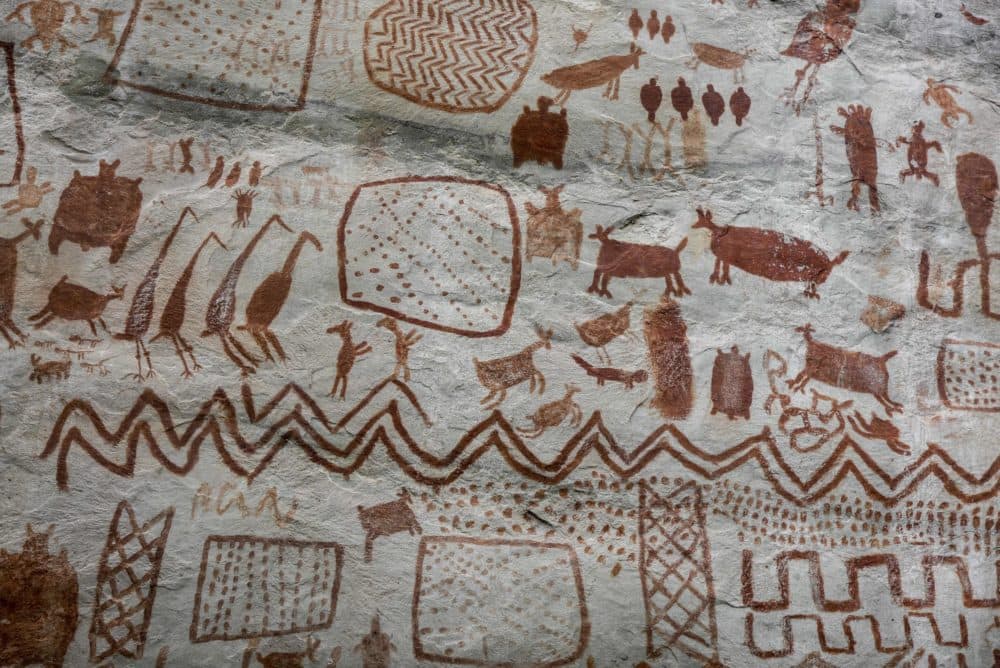Advertisement
Archaeologists Uncover Trove Of Ice Age Paintings In Colombian Amazon

A team of British and Colombian archaeologists has made a spectacular discovery deep in the Amazon rainforest: tens of thousands of paintings strewn across nearly eight miles of cliff faces that date back to the last Ice Age.
The find is being described as “the Sistine Chapel of the ancients” — a trove of ancient paintings made in red ochre that offer a glimpse of a lost civilization.
Mark Robinson, a research fellow in the department of archaeology at the University of Exeter, was one of the members of the expedition in Colombia. He says archaeologists descended from the Bogotá plateau into the Amazon forest’s thick vegetation to observe an outcrop of painted rocks depicting people dancing, laughing and hunting. Handprints and drawings of Ice Age megafauna also were sprawled on the rocks.
The expedition team knew rock art existed far into the tropical forest, but Robinson says social unrest in Colombia made the area inaccessible to researchers. Local Colombians had previously found some rock art in the region and did their own excavations years back, he says.
The archaeologists, along with a camera crew, decided to undergo the long trek and zero in on the large rock outcrops, he says, a place where no researchers have been before.
“We were hoping and praying that they would actually have some rock art on them,” he says. “And not only did they have rock art, they had spectacular rock art.”
Although the discovery was made in 2019, the Guardian reports it was kept under wraps as the team filmed for a series premiering this month called “Jungle Mystery: Lost Kingdoms of the Amazon.”
Robinson says archeologists excavated the base of the rocks to find out when these paintings were drawn. Using radiocarbon dating and context from the images, such as drawings of now-extinct animals, the team determined inhabitants painted the rocks some 12,500 years ago.

The exciting part, besides the discovery itself, is now analyzing who these people were, he says, considering they were some of the very first humans to reach the Amazon at the end of the last Ice Age.
He says 12,000 years ago, humans were still coming out of the Ice Age and the Amazon forest wasn’t as full as it is today. People who migrated down through the Americas traversed a variety of landscapes, he says, meaning they were likely hunter-gatherers who lived off the land.
“But as they start to interact with this environment, they're starting to build their own conceptions of the world, their cosmology, their gods, their religion, their social interactions and then their subsistence, as well as all interacting in one,” he says. “And then they choose to depict some of this on the walls of these rock shelters.”
He says these people were motivated by “the fundamental aspect of what humanity is” — expressing ourselves through culture. In their experience, it was through vivid rock paintings.
Advertisement
The sheer scale of this discovery means that it will likely take archaeologists years, maybe generations, to fully study it. Some of these paintings are painted so high up in the cliff that they can only be viewed using drones. Robinson says to access the art, researchers free climbed and used vines to swing onto higher platforms.
How did these ancient people paint up so high? Robinson says depictions of ladders and scaffolding may hold the answers.
“We assume that they were making some kind of construction using the forest products around there,” he says. “But what is interesting is the amount of effort they went into to actually get to these locations to put art on there — art we can't even see from the ground.”
Archaeologists are hoping to dive deeper into why these Amazonian people used higher elevations for their art and who they meant the paintings to be for, he says.
Being a part of the historic discovery was a dream for Robinson. He says archaeologists like himself are “so used to looking at the dirt itself,” digging for micro remains, that it can be easy to forget the human aspects of archaeology.
“It's hard for us sometimes to maintain that human element to our work,” he says. “To see something which is so closely related to the people — with depictions of people and how they interact — it really does bring the context of life for us.”
Chris Bentley produced and edited this interview for broadcast with Jill Ryan. Serena McMahon adapted it for the web.
This segment aired on December 8, 2020.

